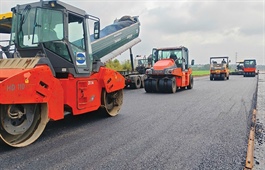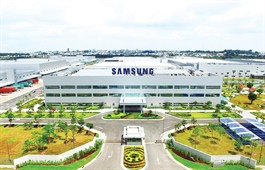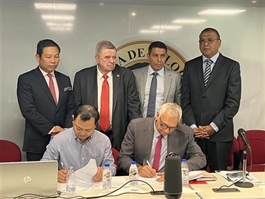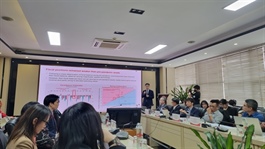The quiet revolution of the steel sector across Vietnam
The quiet revolution of the steel sector across Vietnam
From humble beginnings to industry giants, private steelmakers like Hoa Phat and Hoa Sen are reshaping Vietnam’s industrial future, one furnace at a time.
In the sweltering heat of a steel mill at Dung Quat Economic Zone in the south-central province of Quang Ngai, molten metal glows like lava, flowing steadily through massive channels towards the rolling lines. Just a decade ago, such scenes were rare outside of state-run facilities. Today, steel flows not only from furnaces, but from the determination of private firms that have redefined the rules of the game.
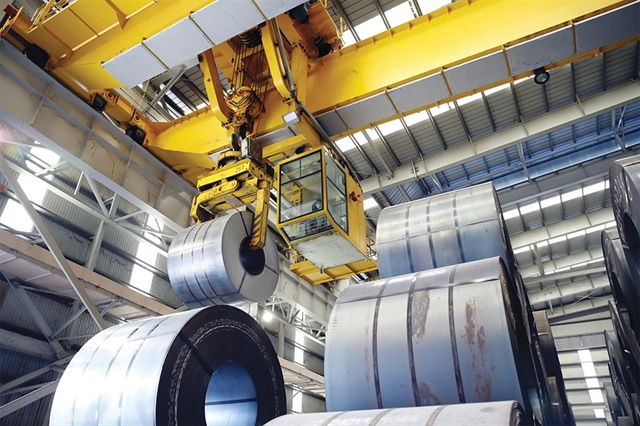
The quiet revolution of the steel sector across Vietnam, photo Duc Thanh |
Once seen as a heavy industry dominated by state-owned enterprises, Vietnam’s steel sector has undergone a quiet revolution. According to the Ministry of Industry and Trade (MoIT), the private sector has assumed the role of locomotive, leading investment and innovation. Before the 2000s, production was led by the Vietnam Steel Corporation with outdated processes and low quality, yielding only about 100,000 tonnes of crude steel per year.
“After the economic reforms and market opening, steel production saw a remarkable transformation thanks to private enterprises like Hoa Phat Group, Hoa Sen Group, and Viet Duc Steel Group,” said Tran Viet Hoa, director of the MoIT’s Department of Industry. “With their financial strength, these businesses invested in advanced technology and high-capacity lines, delivering high-quality, diversified products.”
With infrastructure development a central pillar in the country’s 2045 vision, steel has become the bedrock of industrial growth. Roads, bridges, high-speed railways, and smart urban zones all require consistent, high-quality steel.
According to Hoa, the steel industry is the backbone of black metallurgy and the foundation for forming other key industrial sectors.
“It now nearly fully substitutes imported construction steel, while hot-rolled coil production meets half of domestic demand. Beyond economic impact, the rise of private steelmakers has supported employment across regions, particularly in industrial hubs like Hai Duong, Binh Duong, and Quang Ngai. Thousands of skilled and semi-skilled jobs have been created, indirectly supporting ancillary industries such as logistics, mechanical services, and materials engineering,” Hoa said.
Steel and strategy in a new era
Hoa Phat Group, the largest steelmaker in Vietnam, now controls 35 per cent of the construction steel market. From its $3 billion Dung Quat complex to recent partnerships with Primetals, the company is expanding into high-grade railway, vehicles, and offshore wind.
Speaking at the company’s AGM a few weeks ago, chairman Tran Dinh Long underscored the group’s strategic pivot to prioritise the domestic market. He announced plans to reduce exports below 20 per cent from 31 per cent and focus on national infrastructure projects.
“Never before has the private sector been so supported. This is a golden moment,” he said. He further revealed that the Ministry of Construction is preparing a decree to allocate specific public procurement to domestic producers like Hoa Phat – an important signal of growing synergy between state policy and enterprise strategy
The company’s Dung Quat 2 project is scheduled to start construction in May and begin operations in 2027. The group targets approximately $6.75 billion in revenue for the year, a 21 per cent increase compared to 2024, and a projected after-tax profit of about $595 million, up 24.8 per cent on-year.
In the first quarter of 2025 alone, the group recorded over $1.5 billion in revenue and roughly $131 million in after-tax profit, increases of 22 and 16 per cent, respectively, compared to the same period last year.
In 2024, Vietnam’s production of metal-coated and pre-painted steel sheets reached nearly 5.7 million tonnes, with export volumes accounting for almost three million tonnes, representing 52.5 per cent of total output. The key driver behind these achievements lies in the foundation of quality, supported by technological autonomy and production capacity.
“Many leading players in Vietnam’s steel industry are well-acquainted with trade barriers such as safeguard measures, anti-dumping duties, and quotas, especially from the EU and the US,” Hoa said. “These businesses proactively adjust to international trade policies by diversifying their export markets across dozens of countries, avoiding over-reliance on any single destination. When the EU tightens quotas, companies swiftly redirect exports to less restrictive markets, showcasing their agility in navigating global trade challenges.”
Hoa Sen Group represents another side of private sector dynamism. Specialising in coated steel and roofing, it has mastered branding, distribution, and export strategies.
In 2023, Hoa Sen controlled 25 per cent of the domestic market share and over 30 per cent of exports in coated steel. Its products have reached strict markets like the EU and the US, while fellow private firm Ton Dong A holds 15.5 per cent market share. Private steelmakers now dominate the coated steel segment entirely, highlighting their agility.
Coated steel is essential to many sectors due to its versatility and high demand. It plays a vital role in construction, automotive, household appliances, and electrical industries, serving as both a protective material and a performance enhancer.
Aligning ambition with policy
While Vietnam’s steel sector has made giant strides, it now faces a delicate balancing act: aligning domestic ambitions with global realities. The government’s targets raising national capacity to 40–45 million tonnes annually by 2030.
The World Steel Association projects global consumption to rise by just 1–1.5 per cent per year through the end of the decade, amplifying concerns over potential overcapacity and price volatility. Compounding these challenges are trade barriers and environmental regulations. Countries are turning inward, using anti-dumping measures and carbon taxes to shield their industries.
In response, the Vietnamese government has taken proactive steps. Anti-dumping duties of up to 37 per cent were imposed on steel imports from China and South Korea. Also, Vietnam formally recognises the private sector as central to innovation and digital transformation, signalling stronger state backing for enterprise-led growth. Groups like Hoa Sen and Ton Dong A are also aligning their operations with the EU’s Carbon Border Adjustment Mechanism, investing in low-emission technologies to retain export competitiveness.
According to Hoa Sen Group, in 2025, it targets stable production and business operations to flexibly respond to market fluctuations, while maintaining its position as the largest coated steel producer in Southeast Asia and among the top 10 globally.
Tran Dinh Thien, former director of the Vietnam Institute of Economics, said, “Vietnam’s strategic bet on the private sector in heavy industries like steel shows a shift in mindset. It’s no longer about state ownership but about efficiency, innovation, and integration into global supply chains.”
|
Vietnam’s Ministry of Industry and Trade is in the process of finalising the Steel Industry Development Strategy to 2030, with a vision to 2045. The strategy outlines key goals to transform Vietnam’s steel sector into a modern, sustainable, and competitive industry capable of meeting both domestic and export demands. The draft strategy sets out specific objectives, including encouraging green growth, adopting advanced technologies, and enhancing environmental protection. By 2030, the sector aims to meet the majority of domestic steel demand, reduce dependence on imports of high-grade steel, and improve value chains. By 2045, Vietnam targets to position itself as a leading steel producer in Southeast Asia with global competitiveness. |
- 15:18 03/05/2025





